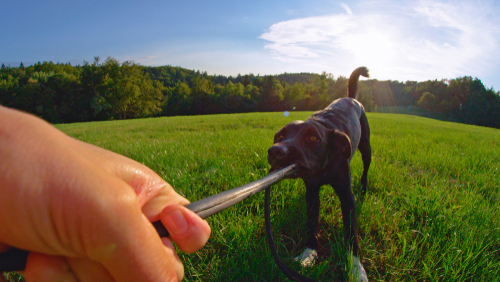Just as there are breeds that are known for their intelligence, loyalty, and obedience, there are breeds that are known for their stubbornness. This includes Beagles, Dachshunds, English Bulldogs, Scottish Terriers, Afghans, Shar-Peis, and more. The good news is that training stubborn breeds CAN be done successfully. Today, we’re taking a look at some Do’s and Don’ts for owners who are working to get their more challenging canine to behave.
Do Take Things Slow
When we’re talking about stubborn breeds, we’re talking about dogs with a strong will to do whatever interests them most. The goal is to make your commands and expectations the priority for your dog, and that doesn’t happen overnight.
At All Dogs Unleashed, we often talk about the importance of consistency. For difficult dogs, you’ll also need patience. Start by creating positive associations between single-step commands like sit and novelty commands like shake or high-five. It may take several weeks of repetition and positive reinforcement for your willful pup to learn that while running around and misbehaving might be fun, responding appropriately to your commands yields the best results.
Don’t Indulge Distractions
Stubborn breeds are often difficult to train because they’re easily distracted. If a squirrel runs through the backyard or another dog passes by on the sidewalk, your dog may go into a frenzy that you can’t seem to control.
Successful training enforces that your dog must look to you before reacting to stimuli. The expectation is that your dog will listen the first time you give them a command, not the second or third or tenth. When you’re completing a training session, start in a low-distraction area like your living room. As you introduce more distractions, stop the training session and relocate when your dog doesn’t respond to a command the first time. Otherwise, you’re teaching them that as long as they respond to you eventually, they can misbehave and still get rewarded.
Don’t Resort to Aggression
When you’re working with a dog that just won’t listen, it’s easy to become overwhelmed and frustrated. Maybe you’ve been working on training for several weeks and your dog is barely responding to single-step commands. Maybe you’ve graduated to more complicated commands like stay or heel, but your dog isn’t showing any interest in these new challenges.
Just as you should walk away and reset when your dog gets distracted, it’s important to take breaks when you feel your temper rising. Dogs typically respond much better to positive reinforcement like treats, praise, and affection. In contrast, verbal or physical aggression can make dogs more fearful or reduce their desire to cooperate.
Do Seek Professional Help
Stubborn breeds may respond best to professional intervention. In fact, this is often the best course of action, as those same stubborn tendencies can lead to aggressive or anxious behaviors that can worsen with time.
At All Dogs Unleashed, our trainers are prepared for and knowledgeable about stubborn breeds. Learn more about how our training programs can help today.



